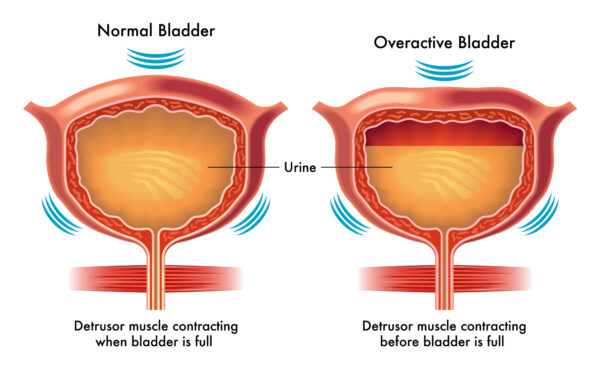
Due to its efficacy and typically well-tolerated nature, Botox has been approved by the FDA for the treatment of overactive bladder.
Involuntary muscle contractions in the bladder wall are the root cause of an overactive bladder. Although more common in females, this bladder condition can affect males as well. Overactive bladder symptoms include:
- Urinary urgency: the immediate need to urinate
- frequent urination during the day or at night: requiring frequent urination
- Urinary incontinence: urine leakage or accidents
An overactive bladder can cause disruptions in your daily activities, including your job, your social life, your relationships, your physical activity, and even your sleep. The good news is that this illness has a viable treatment option.
Cure for Overactive Bladder
Overactive bladder treatments focus on calming down or eliminating bladder wall muscle contractions or spasms.
- Make some adjustments to your routine: drink less alcohol and coffee, and stick to a healthy weight
- Pelvic floor physical therapy: getting those muscles back in shape and working properly
- oral medications
- Botox injections
- sacral neuromodulation (similar to a bladder pacemaker)
- posterior tibial nerve stimulation (stimulating the ankle to improve bladder function).
Many patients report that conventional treatments fail to alleviate their symptoms. When other treatments have failed to alleviate your symptoms, Botox may be the next best thing.
Treatment of Overactive Bladder with Botox
You may have encountered Botox (Onabotulinum toxin A) primarily in the context of its use in the cosmetic industry for addressing signs of aging and reducing wrinkles on the facial skin. On the other hand, it is worth noting that Botox has received FDA approval as a treatment for overactive bladder due to its proven effectiveness and generally positive tolerability.
Botox is derived from a bacterial toxin known as Clostridium botulinum and is utilized in small quantities to address various muscular conditions by inducing temporary muscle relaxation.
Typically, women may observe noticeable changes in urinary symptoms approximately one week following the Botox injection. Additionally, it is worth noting that a significant majority of women tend to observe a notable improvement of approximately sixty to ninety percent in their symptoms.
The effects of Botox are not meant to be permanent, as they gradually diminish over a period of time, usually within a timeframe of between four and twelve months. When experiencing a recurrence of bladder symptoms, it may be possible to consider repeating the Botox injections.
What can one anticipate during Botox bladder treatment?
Botox is injected directly into the bladder muscle during treatment, and a thin telescopic lighted camera (cystoscope) is inserted into the urethra (the tube through which urine is expelled) to perform the procedure. This treatment offers the convenience of being performed in the office without the need for a visit to the operating room, IV administration, sedation, or taking time off work and/or hobbies for recovery. The procedure typically requires approximately 5 minutes to complete, and it is common for patients to spend approximately 60 minutes at the doctor’s office all together.
The Potential Implications of Botox on the Bladder
Botox injections are generally well-tolerated by most individuals. Following the procedure, it is possible to encounter a slight discomfort during urination or observe a minimal presence of blood in the urine. One of the potential side effects that can occur when using Botox for an overactive bladder is the occurrence of a urinary tract infection. Approximately 4 to 8% of patients may experience temporary difficulty emptying their bladder, which may require the use of a small catheter to facilitate urination until the effects of the medication subside.
Get the skills You Need to Administer Botox Injections
Dentox is introducing a new approach to help medical personnel acquire the skills they need to administer Botox injections in an effective and risk-free way. Dentox greatly enhances accessibility to this valuable knowledge, thereby guaranteeing medical professionals can confidently give these injections with a focus on efficacy and security. Discover the profound impact of knowledge as you engage in our awakening seminars, conveniently hosted in a range of places throughout the United States.
Likewise, we invite you to explore the benefits of our flexible learning opportunities by registering for our exciting classes. These lectures are accessible in real-time via our engaging online platform or at your leisure via our on-demand service. The decision is entirely up to you to take the plunge on a transformative journey toward your own development and well-being.
To access more details about our on-site courses and online courses, we kindly invite you to visit the following web pages: https://dentox.com/live-courses and https://dentox.com/all-courses/botox-training. These platforms offer a wealth of information about the programs provided by Dentox, enabling people to fully understand and select the choice that best meets their educational needs.







